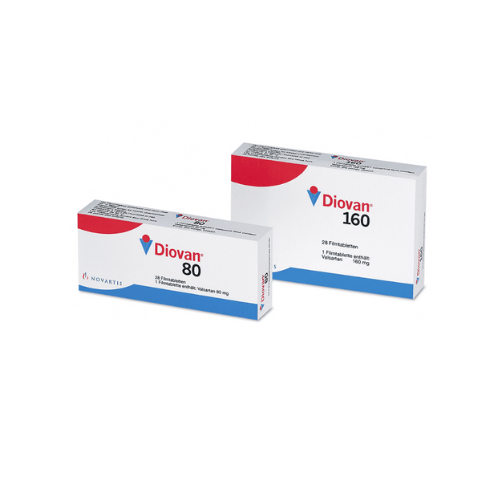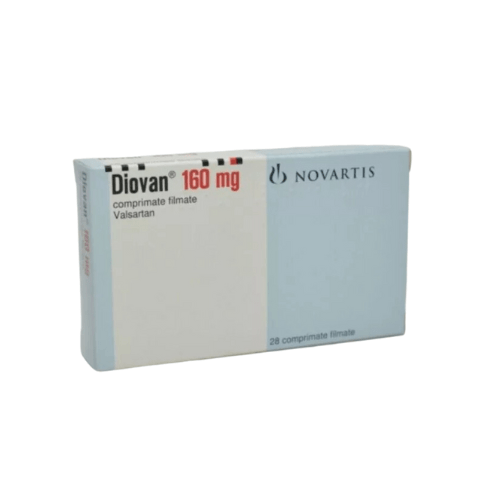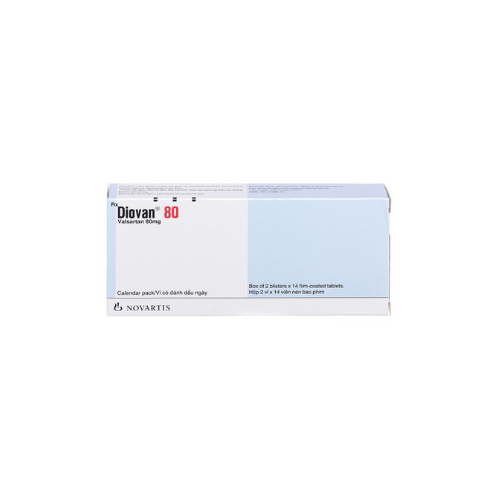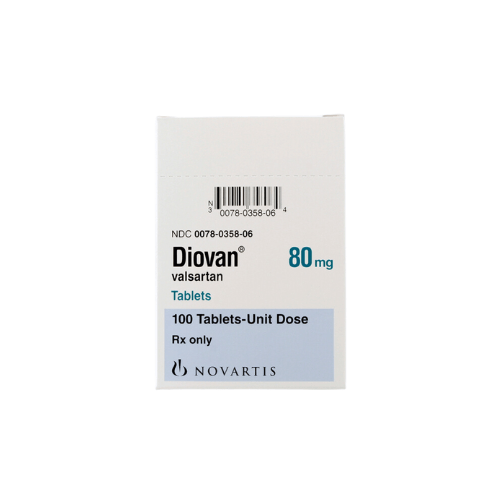Please note: a valid prescription is required for all prescription medication.
Diovan® Tablets for Hypertension
Sitewide Super Sale - Get 15% off when you buy 3 or more of the same product using the code LESS15 at checkout.
Applies to all products originating from Canada. Maximum quantity limited to a 90-day supply per order.
Price range: $67.50 through $69.30
You save


Diovan is a prescription angiotensin II receptor blocker that helps lower blood pressure and reduce cardiovascular risk. It is used alone or with other agents to treat hypertension in adults and some pediatric patients. This page explains how the medicine works, who it may suit, and how to use and store it with confidence, including options for US shipping from Canada without insurance.
What Diovan Is and How It Works
Diovan® contains valsartan, an angiotensin II receptor blocker (ARB). It lowers blood pressure by blocking angiotensin II at the AT1 receptor, which relaxes blood vessels and decreases vascular resistance. It may also be used to improve outcomes after myocardial infarction and to help manage heart failure, as directed by a clinician.
CanadianInsulin.com is a prescription referral platform. We verify prescriptions with your prescriber when required, and licensed Canadian pharmacies dispense your order.
As an ARB, the treatment does not inhibit ACE and usually does not cause ACE‑inhibitor cough. Effects can be influenced by salt intake, diuretics, and kidney function. Always follow your prescriber’s instructions and the official label for this medicine.
Who It’s For
This therapy is indicated for hypertension in adults and for pediatric patients when appropriate by label. It may be used in heart failure or after a heart attack to reduce the risk of cardiovascular events when prescribed for those indications.
People who are pregnant should not use this class due to fetal toxicity risk. Those with hypersensitivity to any component should avoid it. Discuss history of kidney artery stenosis, severe renal impairment, liver disease, low sodium, or dehydration with your clinician. Some patients who need additional control may be candidates for combination options such as hydrochlorothiazide valsartan under medical guidance.
Dosage and Usage
Follow your prescription instructions. The medicine is taken by mouth once or twice daily, with or without food. Try to take it at the same time each day. Swallow tablets whole with water. Your clinician may start at a lower dose and adjust over time.
When moving from another antihypertensive, your prescriber may adjust therapy carefully to minimize dizziness or hypotension. Diuretics can amplify initial blood pressure lowering; your care team may consider timing changes if you feel lightheaded. An example dose sometimes used in practice is 80 mg valsartan, but your dose may differ based on response and indication.
Check blood pressure regularly, especially after dose changes. Do not stop abruptly unless your prescriber advises. If you develop unusual swelling, trouble breathing, fainting, or severe dizziness, seek medical help promptly.
Strengths and Forms
Tablets are commonly available in several strengths. Availability can vary by pharmacy and by country.
- 40 mg, 80 mg, 160 mg, and 320 mg tablets
- Film-coated tablets in multiple colors and shapes depending on strength
- Generic presentations may differ in appearance while containing the same active ingredient
For reference, a strength often discussed in practice is valsartan 160 mg. Your prescriber will select a regimen that matches your condition and tolerability.
Missed Dose and Timing
If you miss a dose, take it when remembered unless it is close to the next dose. If it is almost time, skip the missed tablet and take the next dose at the regular time. Do not double up. Set reminders or use a pill organizer to help maintain a consistent schedule.
If you vomit soon after taking a dose and are unsure whether it was absorbed, monitor how you feel and contact your care team for guidance if needed. Hydration and slow position changes can reduce lightheadedness, especially during the first days on therapy.
Storage and Travel Basics
Store tablets at room temperature in the original container with the lid tightly closed. Keep away from excess moisture, heat, and direct light. Do not store in a bathroom. Keep out of reach of children and pets.
When traveling, bring enough medication for the entire trip plus a small buffer. Pack in carry-on luggage with a copy of your prescription. A weekly pillbox can help organize doses, but retain the labeled container for security checks. If your regimen includes other heart medicines, carry an up-to-date medication list. Use secure storage when staying in shared spaces.
Benefits
ARBs reduce blood pressure by relaxing blood vessels, which can help protect the heart, brain, and kidneys when used as prescribed. The treatment can be combined with compatible agents if additional control is needed. Once-daily options improve convenience for many people. Compared with ACE inhibitors, ARBs may have a lower likelihood of cough.
For those requiring broader cardiovascular care, education and lifestyle support remain essential. If you are managing high blood pressure, you may also find practical reading in our resource on Hypertension Best Practices.
Side Effects and Safety
- Dizziness or lightheadedness, especially after starting or increasing dose
- Headache
- Fatigue
- Gastrointestinal upset
- Back pain or joint discomfort
Serious but less common risks can include hypotension, kidney function changes, and high potassium. Rare angioedema has been reported; seek immediate care for swelling of the face, lips, tongue, or throat. This class carries a boxed warning for fetal toxicity. Do not use during pregnancy; discuss effective contraception if applicable. In heart failure or post‑MI settings, monitoring of blood pressure, potassium, and kidney function is important.
If you also use insulin or certain diabetes medicines that can lower blood pressure via dehydration, lightheadedness can be more likely. NSAIDs may reduce antihypertensive effect and affect kidney function; avoid routine use unless advised. Lithium levels may rise with ARBs; monitoring is recommended if used together.
Drug Interactions and Cautions
Tell your clinician about all medicines and supplements. Notable interactions include:
- Potassium-sparing diuretics or potassium supplements: may increase potassium
- NSAIDs: may blunt blood pressure reduction and affect kidneys
- Aliskiren in diabetes: avoid combined use
- ACE inhibitors: combination may increase risks; specialist oversight needed
- Lithium: potential toxicity; monitor levels
Alcohol may enhance dizziness. Very low-salt diets or dehydration can intensify blood pressure drops. Kidney artery stenosis may raise the risk of renal effects with RAAS agents.
What to Expect Over Time
Blood pressure reduction typically develops over days to weeks and is maintained with consistent dosing. Many people notice improved blood pressure readings on home monitoring when they take the medicine as prescribed and keep a steady routine. If additional control is needed, a clinician may consider titration or add-on therapy from related classes or thiazide-type diuretics.
Heart-healthy changes such as reduced sodium, regular activity, and weight management can support the effect of the medication. Keep scheduled lab checks for potassium and kidney function when requested. If your plan changes after a heart event, your team will tailor therapy to evolving needs.
Compare With Alternatives
The generic active ingredient option is Valsartan, which contains the same ARB. For patients needing a diuretic add-on, clinicians may suggest a fixed-dose combination such as Valsartan HCT to simplify the regimen. Some people may also be managed with calcium channel blocker combinations; an example is amlodipine valsartan prescribed when clinically appropriate.
ACE inhibitors like enalapril or lisinopril are alternatives for some patients. For broader education on blood pressure therapies and risk reduction, see our overview of SGLT2 Inhibitors and their role in cardiovascular care when combined with guideline-directed therapy.
Pricing and Access
Canadian pricing may offer value for US patients. You can review the cost of diovan on our product page after selecting the prescribed quantity. For general savings opportunities, you may also check Promotions for periodic offers.
We provide transparent product pages so you can confirm strength availability and pharmacy source. Orders are dispensed by licensed Canadian pharmacies and shipped to US addresses. This service ships from Canada to US with clear billing and tracking. Use our catalog to compare brand and generic options before you proceed to checkout.
Availability and Substitutions
Supply can vary between pharmacies. If a particular strength is temporarily unavailable, your prescriber may recommend a therapeutically equivalent alternative or another strength with an adjusted schedule. When appropriate, a generic drug for diovan may be considered to meet your prescription requirements.
Some patients may transition to combinations when added diuretic effect is needed. Examples include valsartan with hydrochlorothiazide in typical fixed ratios. Your prescriber will decide whether a single-agent ARB or a combination product is suitable.
Patient Suitability and Cost-Saving Tips
This ARB may suit adults who need blood pressure control and cannot tolerate ACE inhibitors. It may also be used post‑MI or in heart failure when appropriate by label. Patients with a history of angioedema to ARBs, pregnancy, or severe kidney issues may not be candidates.
To save on therapy, consider multi-month fills if your prescriber approves. Align refills with routine checkups and set reminders in your phone. Generic options often lower out-of-pocket costs. If you are looking for potential discounts, you can ask about a diovan coupon on applicable product pages or promotions, subject to availability.
Questions to Ask Your Clinician
- Is an ARB appropriate given my medical history?
- What monitoring for kidney function and potassium do I need?
- Should I take this once daily or split the dose?
- Could I benefit from adding a thiazide diuretic?
- How does this interact with my NSAIDs or lithium?
- What are my home blood pressure targets?
Authoritative Sources
For complete prescribing details and safety information, consult the official labeling below. These sources provide full indications, contraindications, and administration guidance.
- Novartis Diovan US Prescribing Information, detailed indications and safety
- FDA DailyMed Valsartan, full label and patient information
- Health Canada Drug Product Database listing, product entry and status
Missed Dose and Timing
If you forget a dose, take it when you remember unless it is close to the next scheduled time. If it is almost time, skip the missed dose and resume your usual schedule. Do not double doses.
Storage and Travel Basics
Keep tablets dry and at room temperature. Use child-resistant containers, and secure the supply when traveling. Carry a printed or digital prescription record during trips and keep a medication list for emergencies.
Place the medication in a cool, shaded section of your bag. Avoid glove compartments and window sills. If you use pill organizers, keep a portion in the original labeled bottle for identification.
Drug Interactions and Cautions
Review all therapies with your clinician. This includes over-the-counter pain relievers, herbal products, and supplements that affect blood pressure or kidney function. Avoid salt substitutes high in potassium unless advised.
Learn more about related conditions and therapies in our category pages for Hypertension, Heart Failure, and Cardiovascular care.
Ready to proceed? You can place your order with prompt, express shipping with temperature-controlled handling when required. Medical disclaimer: This content is for informational purposes only and is not a substitute for professional medical advice.
Express Shipping - from $25.00
Shipping with this method takes 3-5 days
Prices:
- Dry-Packed Products $25.00
- Cold-Packed Products $35.00
Standard Shipping - $15.00
Shipping with this method takes 5-10 days
Prices:
- Dry-Packed Products $15.00
- Not available for Cold-Packed products
Is Diovan the same as valsartan?
Diovan is the brand name for valsartan. Both contain the same active ingredient. Your clinician can determine whether brand or generic is appropriate for you.
How long does Diovan take to work?
Blood pressure effects can begin within days and stabilize over weeks with consistent use. Follow your prescriber’s instructions and continue monitoring at home.
Can I take Diovan with a diuretic?
Many patients use an ARB with a thiazide diuretic when extra control is needed. Your prescriber may recommend a fixed-dose combination if appropriate.
What if my blood pressure is still high on Diovan?
Do not change your dose on your own. Speak with your clinician about adherence, lifestyle measures, and whether a dose adjustment or add-on therapy is needed.
Who should not take Diovan?
Avoid this medicine in pregnancy, in patients with known hypersensitivity, and with aliskiren in diabetes. Use caution in severe kidney or liver disease.
Can I drink alcohol while on Diovan?
Alcohol may increase dizziness and lower blood pressure further. If you drink, do so cautiously and discuss limits with your clinician.
How should I store Diovan tablets?
Store at room temperature in a dry place away from light. Keep tablets in the original container, tightly closed, and out of reach of children.
Rewards Program
Earn points on birthdays, product orders, reviews, friend referrals, and more! Enjoy your medication at unparalleled discounts while reaping rewards for every step you take with us.
You can read more about rewards here.
POINT VALUE
How to earn points
- 1Create an account and start earning.
- 2Earn points every time you shop or perform certain actions.
- 3Redeem points for exclusive discounts.
You Might Also Like
Related Articles
Zepbound storage: Keep It Safe With Clear Temperature Rules
This guide explains Zepbound storage so your medication stays effective. You will learn temperature limits, how long doses can stay unrefrigerated, travel practices, and what to do if a pen…
Zepbound and Fatigue: Practical Tips to Ease Tiredness Safely
Feeling drained after starting tirzepatide can be unsettling. Many users describe a mix of low energy, mild aches, and disrupted sleep early on. If you are navigating Zepbound and fatigue,…
Mounjaro Heart Benefits Beyond Weight Loss: Evidence-Based Guide
Interest has grown around Mounjaro heart benefits as clinicians evaluate tirzepatide’s broader impact beyond glucose control and weight. Patients want clear, cautious guidance. This overview explains what current data suggests,…
Ozempic Rebound: A Practical Guide to Prevent Weight Regain
Many people stop GLP-1 therapy and wonder what comes next. Appetite changes, routine shifts, and metabolism can collide. A clear plan helps you keep progress steady and predictable, not reactive.…




